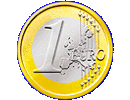
DATAMATH CALCULATOR MUSEUM
 |
DATAMATH CALCULATOR MUSEUM |
Texas Instruments €-1796
| Date of introduction: | 2000 | Display technology: | LCD |
| New price: | Display size: | 10 | |
| Size: | 5.7" x 4.3" x
1.0" 145 x 109 x 25 mm3 |
||
| Weight: | 3.9 ounces, 111 grams | Serial No: | |
| Batteries: | LR54 | Date of manufacture: | mth 06 year 2001 |
| AC-Adapter: | Origin of manufacture: | China (N) | |
| Precision: | 10 | Integrated circuits: | |
| Memories: | 1 | ||
| Program steps: | Courtesy of: | Joerg Woerner |
 The
€-1796 calculator combines the usual desktop basic calculator functions with a very
convenient Euro
currency conversion. All of the 11 defined exchange rates are preprogrammed
in the calculator, 4 additional ones could be added at a later time. The home country is
selected with the Select-key. Two additional keys allow the conversion in both
directions. A similar calculator in a smaller housing was introduced with the €-2001.
The
€-1796 calculator combines the usual desktop basic calculator functions with a very
convenient Euro
currency conversion. All of the 11 defined exchange rates are preprogrammed
in the calculator, 4 additional ones could be added at a later time. The home country is
selected with the Select-key. Two additional keys allow the conversion in both
directions. A similar calculator in a smaller housing was introduced with the €-2001.
A simpler calculator was sold with the €-2002+, an enhanced calculator with the €-2003. In non-EU countries the TI-1796SV was sold instead.
If you visited in the 2000-2003 timeframe the Texas Instruments website for educational products you should have noticed the €-1796 in a white housing like the TI-1796SV. It seems to be a mockup but the first prototypes of the €-1796 sported indeed an off white to gray housing.
In 2006 Texas Instruments surprised customers in Europe with a complete new family of Euro Calculators labeled EC-3, EC-5 and EC-7 Pro.
An expert group of the European Community (EC) started in the year 1994 to set up plans to use in the near future a single currency, the Euro. The report proposed to introduce the Euro in three phases:
| • In May 1998, in accordance with the procedure laid down in the Maastricht Treaty, the countries, which were to take part in the first wave of the EMU (European Monetary Union), were announced. |
| • On January 1st, 1999, EMU will effectively start among the countries concerned, with the rates of conversion between the Euro and the participating currencies being irrevocably fixed. |
| • On January 1st, 2002, the introduction of the new bank notes and coins will signal the final conversion to the Euro as the single currency of the countries taking part in EMU. |
The reason for calculators like the €-line from Texas Instruments is that the Euro was formed by merging eleven national currencies at fixed exchange rates on 1.1.1999. They will persist in visible form (notes and coins) for three years until the final changeover on 1 January 2002. Therefore conversions between national currencies in the Euro are not like normal exchange rates with variable rates; they are simply a different measurement of the same underlying entity, just like pounds and kilogrammes are different scales of measurement of weight. They have fixed six-digit conversion rates (not "exchange" rates). And because of the three-year transition period, economic entities must be able to handle both kinds of money from those they deal with.
 Read
more about the Euro
here.
Read
more about the Euro
here.
| 1€ = | Icon | Currency | Country |
| 40.3399 | BEF | Belgian Franc | Belgium |
| 1.95583 | DEM | Deutsche Mark | Germany |
| 166.386 | ESP | Peseta | Spain |
| 6.55957 | FRF | French Franc | France |
| 0.787564 | IEP | Irish Pound | Ire |
| 1936.27 | ITL | Italian Lira | Italy |
| 40.3399 | LUF | Luxemburg Franc | Luxembourg |
| 2.20371 | NLG | Dutch Gilder | Netherland |
| 13.7603 | ATS | Austrian Schilling | Austria |
| 200.482 | PTE | Portuguese Escudo | Portugal |
| 5.94573 | FIM | Fin Mark | Finland |
| CC1 | Reserved for the other | ||
| CC2 | countries in EC not taking | ||
| CC3 | part of the EMU | ||
| CC4 |
If you have additions to the above article please email: joerg@datamath.org.
© Joerg Woerner, January 21, 2002. No reprints without written permission.